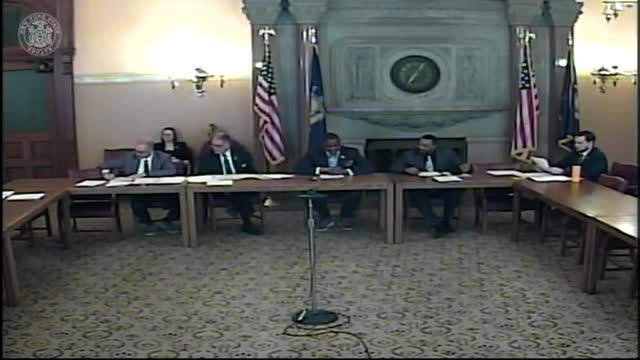Senate discusses New York's energy reforms and advancing renewable technologies
February 25, 2025 | 2025 Legislature NY, New York
This article was created by AI summarizing key points discussed. AI makes mistakes, so for full details and context, please refer to the video of the full meeting. Please report any errors so we can fix them. Report an error »

In a bustling chamber filled with the echoes of bipartisan dialogue, the New York Senate Standing Committee on Energy and Telecommunications convened on February 25, 2025, to discuss a series of pivotal energy bills. The atmosphere was charged with a sense of urgency as lawmakers navigated the complexities of energy policy, aiming to enhance the state's infrastructure and sustainability efforts.
The meeting kicked off with a focus on Bill 2708, sponsored by Senator May, which seeks to amend public service laws to promote grid enhancement technologies. The committee swiftly moved the bill to third reading, signaling a collective agreement on the importance of modernizing New York's energy grid.
Next on the agenda was Bill 3503, introduced by Senator Claire, which mandates that investor-owned energy utilities publish educational materials on their customer-facing websites. This initiative aims to improve transparency and consumer awareness in the energy sector. The bill also passed through to the next stage with minimal opposition.
Senator Mayer's Bill 3734, which aims to prevent the Public Service Commission from approving certain rate increases, sparked a lively discussion. Despite two dissenting votes, the bill was also advanced, reflecting the committee's commitment to scrutinizing utility costs for consumers.
Another significant proposal, Bill 4571, introduced by Senator Hartman, seeks to establish a floating solar incentive and education program. While the bill faced some skepticism, it was moved to the finance committee for further consideration, highlighting the ongoing exploration of innovative renewable energy solutions.
The final bill discussed was Bill 4590, sponsored by Senator Parker, which proposes the establishment of the New York State Bridal Modernization Commission. This bill, too, was sent to finance, indicating a broader interest in modernizing various aspects of the state's energy framework.
As the meeting progressed, a critical conversation emerged regarding the transportation of frozen natural gas and its environmental implications. One senator raised concerns about the reliance on diesel trucks for transporting this energy source, emphasizing the need for a shift towards more sustainable practices. The committee acknowledged the importance of transitioning to renewable energy sources, with discussions touching on the challenges of offshore wind projects and the potential for modular nuclear power stations.
The dialogue underscored a fundamental disagreement among committee members regarding the effectiveness of current battery storage technologies. While some expressed skepticism about the feasibility and safety of large-scale battery storage, others defended its potential as part of a diversified energy strategy. The committee recognized the complexity of achieving the state's climate goals, emphasizing that no single solution would suffice.
As the meeting concluded, the committee members left with a renewed sense of purpose, aware that the path to a sustainable energy future would require collaboration, innovation, and a willingness to explore diverse energy solutions. The discussions held today will undoubtedly shape New York's energy landscape for years to come, as lawmakers continue to grapple with the pressing challenges of energy production and consumption in an evolving world.
The meeting kicked off with a focus on Bill 2708, sponsored by Senator May, which seeks to amend public service laws to promote grid enhancement technologies. The committee swiftly moved the bill to third reading, signaling a collective agreement on the importance of modernizing New York's energy grid.
Next on the agenda was Bill 3503, introduced by Senator Claire, which mandates that investor-owned energy utilities publish educational materials on their customer-facing websites. This initiative aims to improve transparency and consumer awareness in the energy sector. The bill also passed through to the next stage with minimal opposition.
Senator Mayer's Bill 3734, which aims to prevent the Public Service Commission from approving certain rate increases, sparked a lively discussion. Despite two dissenting votes, the bill was also advanced, reflecting the committee's commitment to scrutinizing utility costs for consumers.
Another significant proposal, Bill 4571, introduced by Senator Hartman, seeks to establish a floating solar incentive and education program. While the bill faced some skepticism, it was moved to the finance committee for further consideration, highlighting the ongoing exploration of innovative renewable energy solutions.
The final bill discussed was Bill 4590, sponsored by Senator Parker, which proposes the establishment of the New York State Bridal Modernization Commission. This bill, too, was sent to finance, indicating a broader interest in modernizing various aspects of the state's energy framework.
As the meeting progressed, a critical conversation emerged regarding the transportation of frozen natural gas and its environmental implications. One senator raised concerns about the reliance on diesel trucks for transporting this energy source, emphasizing the need for a shift towards more sustainable practices. The committee acknowledged the importance of transitioning to renewable energy sources, with discussions touching on the challenges of offshore wind projects and the potential for modular nuclear power stations.
The dialogue underscored a fundamental disagreement among committee members regarding the effectiveness of current battery storage technologies. While some expressed skepticism about the feasibility and safety of large-scale battery storage, others defended its potential as part of a diversified energy strategy. The committee recognized the complexity of achieving the state's climate goals, emphasizing that no single solution would suffice.
As the meeting concluded, the committee members left with a renewed sense of purpose, aware that the path to a sustainable energy future would require collaboration, innovation, and a willingness to explore diverse energy solutions. The discussions held today will undoubtedly shape New York's energy landscape for years to come, as lawmakers continue to grapple with the pressing challenges of energy production and consumption in an evolving world.
View full meeting
This article is based on a recent meeting—watch the full video and explore the complete transcript for deeper insights into the discussion.
View full meeting
